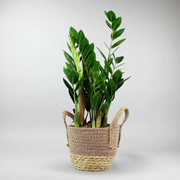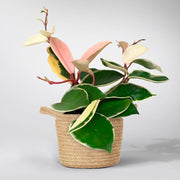And if you need some extra hints and tips, we’ve added some below the fold.
Don't worry if you tend to forget to water your plants! Though garden plants need a regular soaking during the summer months, the majority of indoor plants like a break between waterings. This is good news if you’re looking for plants for a shared space, where they may get left for a few days or more. Whatever plant you choose, make sure it works for you and helps create a space where you’ll feel comfortable.
Before we jump into the different sub-categories, we'd like to introduce you to one of our long-time favourites: the Devil's Ivy N'Joy. It's got bright green leaves that will get white variegation with enough bright indirect light. When you get it delivered to your home, it will be relatively small, but you'll be surprised at how quickly it'll grow. As it prefers less water than too much, this could be a great choice for your space!
When we mention succulents, you probably immediately think of cacti. This family of plants is so much more diverse than many of us might think, though. The best example is the Fishbone Cactus. Its long, wavy stems give it a distinctive look that will lift the interior of any room. With a good bit of sunshine and a tad of cactus feed, you might even get it to flower at the end of summer.
Aloes are another big succulent family. The gel in their fronds has been used for its healing properties for millennia! Whether bright sunshine or dry heating air, the Candelabra Aloe can withstand it all. This statuesque variety will store water in its fronds, so it tolerates a little neglect. Pop it wherever, and it will be a happy chap!
Last but not least, you should consider Snake Plants. They're a tough bunch who don't even mind imperfect light conditions. The Mother in Law Tongue Zeylanica has flat fronds that grow upright, glowing in different shades of green. With its air-purifying abilities, this plant lifts the look of any room whilst improving its air quality.
All plants need some natural light, but some are more tolerant of low light than others. Plus, plants are a great way of livening up your interior and creating an ambiance. You might be wondering what your options are, so our plants experts have compiled some recommendations. Take your pick, whatever works best for you and your home!
One of the toughest indoor plants is the ZZ plant. This palm likes any spot that's away from direct sunlight, making it a super versatile green companion. The evergreen plant has glossy leaves on upright stems that will add structure to your plant collection. Top tip: with less natural light, it also needs less water.
If you're looking to add rich, dark tones to your green oasis, the Peperomia caperata 'Schumi Red' is a real eye-catcher. Its heart-shaped, textured leaves come in colours ranging from dark burgundy to (almost) black. When you walk past it, we guarantee you'll want to stroke its leaves, and we urge you to go right ahead! This is all part of building a nurturing relationship with your plant.
Depending on your home, you might want to hang up a plant or put one on top of a cupboard. When put there, they start to blend into the décor so much that you might forget to water them. Plenty of sturdy plants can handle (some) neglect, so don't worry!
Make your room super dreamy by letting the Satin Pothos trail from your shelf. Before you water it, make sure the top layer of soil dries out. This low-maintenance plant can handle a range of light levels, making it a truly versatile plant. Add the Pothos to your home to create a vibrant yet restorative atmosphere.
One of the most popular types of hanging plants are ferns. With its impressive green foliage sprouting out of the pot, the Kangaroo Fern is a must-have for fans of the urban jungle look. We deliver it in a hanging pot so you can put it up as soon as our couriers have delivered it to you. This vibrant green plant prefers spots with medium to bright light and needs watering once the soil dries out.
Most of us live in areas that are not as close to nature as we'd like: our concrete jungles are a far cry from the wild habitats we are adapted to. By having plants at home, you can create your own green oasis. The good news is that your houseplants bring the positive effects we experience in nature into your home. This can benefit your wellbeing in several ways.
Don’t get us wrong, in many ways the technology and gadgets we surround ourselves with have changed our lives for the better. Yet, they also mean we're spending a lot of time in front of screens, shining blue light at us, which drains our focus and concentration. But evidence suggests introducing plants to your office to increase productivity and focus.
You've probably noticed that you tend to be in a better mood after spending some time in nature. Psychologists associate this emotional uplift with the colour green. It makes us feel healthy and vital. Create a better work environment for yourself by adding some greenery to your side table, for example the Philodendron Atom.
Plants have tiny pores embedded in their foliage which are essential for their photosynthesis. When plants 'breathe in', they take in CO2 as well as pollutants. By reducing the level of toxins in the air, your easy care plants can support your respiratory system. The Aralia Fabian is particularly good at this since it has lots of circular leaves sprouting on its upright stems.
Many indoor plants are native to tropical environments, meaning they've naturally adapted to humid conditions. Some of these green wonders can act as natural humidifiers themselves if you keep them misted. To make your life a bit easier, you can also set the pot on a tray of wet pebbles, which will help boost the humidity around your plant with very minimal effort on your part.
What Is a Low Maintenance Indoor Plant?
Low maintenance indoor plants are our favourite type of easy indoor plants. These are indoor plants that add colour, vibrancy and beauty to your home, without requiring extensive care regimes and effort. They also thrive without support and attention.
If you already have a stressful jam-packed life, job, or routine, then these are the plants for you.
What are Easiest Indoor Plants To Keep Alive?
We have prepared a short list of some of the easiest indoor plants to keep alive in the UK. Be it because they require little water or daylight, can endure cold UK winters or because they are just extremely robust and durable - these house plants will not forsake you.
The Shark Fin
The Shark Fin is a particularly hardy indoor plant. This unusual-looking shark-fin shaped mono-phytic species has just one single leaf in the shape of a sail/fin - giving it its unique name.
This plant is renowned for its inability to die - in fact, it is almost impossible to kill! You can leave it in a bathroom, study or corridor, adding a splash of colour and natural beauty, without having to worry about killing it.
The Spiral Cactus
The Spiral Cactus is a 'twist' on the popular cactus variety of cereus forbesii. This spiralling column-style cactus is striking, vibrant and unmissable, making it perfect for a plain corner in need of some excitement. This particular cactus comes in a 19cm diameter growing pot so is also of a pretty impressive size and will have been growing happily for years.
This cactus thrives on neglect, requiring little to no watering, fertiliser or plant care. It grows best in a warm, sunny room. As long as you don't overwater or “overcare,” your Spiral Cactus will grow with you for years.


































































